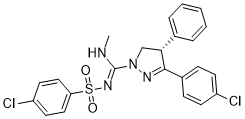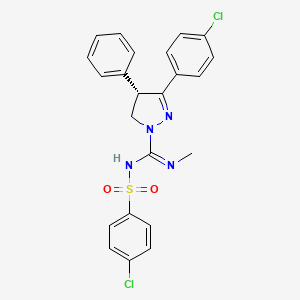

Ibipinabant
| cas 464213-10-3; UNII-O5CSC6WH1T; BMS-646256; SLV-319; |
| Molecular Formula: | C23H20Cl2N4O2S |
|---|---|
| Molecular Weight: | 487.4015 g/mol |
(4S)-5-(4-chlorophenyl)-N-(4-chlorophenyl)sulfonyl-N’-methyl-4-phenyl-3,4-dihydropyrazole-2-carboximidamide
1H-Pyrazole-1-carbo
(4S)-3-(4-Chlorophenyl)-N-[(4-chlorophenyl)sulfonyl]-4,5-dihydro-N’-methyl-4-phenyl-1H-pyrazole-1-carboximidamide
1H-Pyrazole-1-carboximidamide, 3-(4-chlorophenyl)-N-[(4-chlorophenyl)sulfonyl]-4,5-dihydro-N‘-methyl-4-phenyl-, (4S)-
(-)-(4S)-N-Methyl-N’-((4-chlorophenyl)sulfonyl)-3-(4-chlorophenyl)-4,5-dihydro-4-phenyl-1 H-pyrazole-1 -carboxamidine
4S)-(−)-3-(4-Chlorophenyl)-N-methyl-N‘-[(4-chlorophenyl)sulfonyl]-4-phenyl-4,5-dihydro-1H-pyrazole-1-carboxamidine
It was originally developed by Solvay, which was acquired by Abbott in 2010.
SLV 319, UNII:O5CSC6WH1T, (S)-SLV 319, BMS 646256, JD 5001
- Originator Solvay
- Class Antipsychotics; Imides; Obesity therapies; Pyrazoles; Small molecules; Sulfonamides
- Mechanism of ActionCannabinoid receptor CB1 antagonists
Ibipinabant, also known as BMS-646256, JD-5001 and SLV-319, is a potent and highly selective CB1 antagonist. It has potent anorectic effects in animals, and was researched for the treatment of obesity, although CB1 antagonists as a class have now fallen out of favour as potential anorectics following the problems seen with rimonabant, and so ibipinabant is now only used for laboratory research, especially structure-activity relationship studies into novel CB1 antagonists
Ibipinabant (SLV319, BMS-646,256) is a drug used in scientific research which acts as a potent and highly selective CB1antagonist.[1] It has potent anorectic effects in animals,[2] and was researched for the treatment of obesity, although CB1 antagonists as a class have now fallen out of favour as potential anorectics following the problems seen with rimonabant, and so ibipinabant is now only used for laboratory research, especially structure-activity relationship studies into novel CB1 antagonists.[3][4][5]

| Inventors | Josephus H.M. Lange, Cornelis G Kruse,Jacobus Tipker, Jan Hoogendoorn |
| Applicant | Solvay Pharmaceuticals B.V. |
PATENT
WO 2002076949
https://www.google.com/patents/WO2002076949A1?cl=en
Example IV
(-)-(4S)-N-methyl-N’-((4-chlorophenyl)sulfonyl)-3-(4-chlorophenyl)-4,5- dihydro-4-phenyl-1 H-pyrazole-1 -carboxamidine
(-)-(4S)-N-Methyl-N’-((4-chlorophenyl)sulfonyl)-3-(4-chlorophenyl)-4,5-dihydro-4-phenyl-1 H-pyrazole-1 -carboxamidine (7.16 gram, 0.0147 mol)) ([α25 D] = -150°, c = 0.01 , MeOH) (melting point: 169-170 °C) was obtained via chiral chromatographic separation of racemic N-methyl-N’-((4-chlorophenyl)sulfonyl)-3- (4-chlorophenyl)-4,5-dihydro-4-phenyl-1 H-pyrazole-1 -carboxamidine (18 gram, 0.037 mol) using a Chiralpak AD, 20 μm chiral stationary phase. The mobile phase consisted of a mixture of hexane/ethanol (80/20 (v/v)) and 0.1 % ammonium hydroxide (25 % aqueous solution).
Example III N-Methyl-N’-((4-chlorophenyl)sulfonyl)-3-(4-chlorophenyl)-4,5-dihydro-4- phenyl-1 H-pyrazole-1 -carboxamidine
Part A: To a solution of N-((4-chlorophenyl)sulfonyl)carbamic acid methyl ester (CAS: 34543-04-9) (2.99 gram, 12.0 mmol) and pyridine (4 ml) in 1 ,4-dioxane (20 ml) is added 3-(4-chlorophenyl)-4,5-dihydro-4-phenyl-1 H-pyrazole (3.39 gram, 13.2 mmol) and the resulting mixture is stirred for 4 hours at 100 °C After concentration in vacuo the residue is dissolved in dichloromethane, successively washed with water, 1 N HCI and water, dried over anhydrous Na2SO4, filtered and concentrated in vacuo to a volume of 20 ml. Methyl-tert-butyl ether (60 ml) is added and the resulting solution is concentrated to a volume of 20 ml. The formed crystals are collected by filtration and recrystallised from methyl-te/τ-butyl ether to give 3-(4-chlorophenyl)-N-((4-chlorophenyl)sulfonyl)-4,5-dihydro-4-phenyl-1 H- pyrazole-1-carboxamide (4J5 gram, 76 % yield) Melting point: 211-214 °C
Part B: A mixture of 3-(4-chlorophenyl)-N-((4-chlorophenyl)sulfonyl)-4,5-dihydro- 4-phenyl-1 H-pyrazole-1 -carboxamide (3.67 gram, 7J5 mmol) and phosphorus pentachloride (1.69 gram, 8.14 mmol) in chlorobenzene (40 ml) is heated at reflux for 1 hour. After thorough concentration in vacuo, the formed N-((4- chlorophenyl)sulfonyl)-3-(4-chlorophenyl)-4,5-dihydro-4-phenyl-1 H-pyrazole-1- carboximidoyl chloride is suspended in dichloromethane and reacted with cold methylamine (1.5 ml). After stirring at room temperature for 1 hour, the mixture is concentrated in vacuo. The residue is crystallised from diethyl ether to give N-methyl-N’-((4-chlorophenyl)sulfonyl)-3-(4-chlorophenyl)-4,5-dihydro-4-phenyl- 1 H-pyrazole-1 -carboxamidine (2.29 gram, 61 % yield). Melting point: 96-98 °C(dec).
PATENT
WO 2008074816
https://google.com/patents/WO2008074816A1?cl=en
PAPER
An expedient atom-efficient synthesis of the cannabinoid CB1receptor inverse agonist ibipinabant
- Abbott Healthcare Products B.V., Chemical Design & Synthesis Unit, C.J. van Houtenlaan 36, 1381 CP Weesp, The Netherlands
http://www.sciencedirect.com/science/article/pii/S0040403911000955
http://dx.doi.org/10.1016/j.tetlet.2011.01.068

A novel synthetic route to the highly selective and orally active cannabinoid CB1 receptor inverse agonist ibipinabant is described which combines the use of inexpensive, commercially available reagents and mild reaction conditions with a high degree of atom-efficiency. The method is expected to enable the rapid synthesis of a variety of sulfonylguanidines.
PAPER
JD-5006 and JD-5037: Peripherally restricted (PR) cannabinoid-1 receptor blockers related to SLV-319 (Ibipinabant) as metabolic disorder therapeutics devoid of CNS liabilities
- Jenrin Discovery, 2515 Lori Lane North, Wilmington, DE 19810, USA
http://dx.doi.org/10.1016/j.bmcl.2012.08.004
http://www.sciencedirect.com/science/article/pii/S0960894X12009936

- Scheme 1.
Reagents and conditions: (a) ArylSO2NHCO2CH3, toluene, reflux, 3–6 h, 30–95%; (b) PCl5, chlorobenzene, reflux, 2–4 h, 50–90%; (c) NH2Me.HCl, Et3N, CH2Cl2, ice-bath to rt, 16–20 h, 30–70%; (d) X = CO2Et/X′ = CO2H: LiOH, H2O/THF(1:3), 50%; X′ = CO2H/X′ = CONH2, (1) IBCF, NMM, CH2Cl2, (2) NH3/THF, 60%; X′ = CO2H/X′ = CONHOH, (1) IBCF, NMM, CH2Cl2, (2) NH2OH·HCl, NMM, CH2Cl2, 40%; X = OCH2CO2Et/OCH2CO2H: LiOH, H2O/THF(1:3), rt, 50%; X′ = OCH2CO2H/X′ = OCH2CONH2: (1) IBCF, NMM, CH2Cl2, (2) NH3/THF, 30%; X = NO2:/X′ = NHCOCH3: (1) Fe/HCl, EtOH, H2O, reflux 1–2 h, 90%; (2) Ac2O, pyr, CH2Cl2, rt, 8 h, 90%; X = NO2:/X′ = NHCO2Et: (1) Fe/HCl, EtOH, H2O, reflux 1–2 h, 90%; (2) ClCO2Et, pyr, CH2Cl2, 0 °C to rt, 8 h, 90%
Clip
http://molpharm.aspetjournals.org/content/87/2/197.full.pdf
Paper
Lange et al (2005) Novel 3,4-diarylpyrazolines as potent cannabinoid CB1 receptor antagonists with lower lipophilicity. Bioorg.Med.Chem.Lett. 15 4794. PMID: 16140010.
http://www.sciencedirect.com/science/article/pii/S0960894X05010139
http://dx.doi.org/10.1016/j.bmcl.2005.07.054
Paper
Lange et al (2004) Synthesis, biological properties, and molecular modeling investigations of novel 3,4-diarylpyrazolines as potent and selective CB1 cannabinoid receptor antagonists. J.Med.Chem. 47 627. PMID:14736243.
A series of novel 3,4-diarylpyrazolines was synthesized and evaluated in cannabinoid (hCB1 and hCB2) receptor assays. The 3,4-diarylpyrazolines elicited potent in vitroCB1 antagonistic activities and in general exhibited high CB1 vs CB2 receptor subtype selectivities. Some key representatives showed potent pharmacological in vivo activities after oral dosing in both a CB agonist-induced blood pressure model and a CB agonist-induced hypothermia model. Chiral separation of racemic 67, followed by crystallization and an X-ray diffraction study, elucidated the absolute configuration of the eutomer 80 (SLV319) at its C4 position as 4S. Bioanalytical studies revealed a high CNS−plasma ratio for the development candidate 80. Molecular modeling studies showed a relatively close three-dimensional structural overlap between 80 and the known CB1 receptor antagonist rimonabant (SR141716A). Further analysis of the X-ray diffraction data of 80 revealed the presence of an intramolecular hydrogen bond that was confirmed by computational methods. Computational models and X-ray diffraction data indicated a different intramolecular hydrogen bonding pattern in the in vivo inactive compound 6. In addition, X-ray diffraction studies of 6 revealed a tighter intermolecular packing than 80, which also may contribute to its poorer absorption in vivo. Replacement of the amidine -NH2 moiety with a -NHCH3 group proved to be the key change for gaining oral biovailability in this series of compounds leading to the identification of 80

 ] = −150°, c = 0.01, MeOH; mp 171−172 °C;
] = −150°, c = 0.01, MeOH; mp 171−172 °C;  ] = + 150°, c = 0.01, MeOH; mp 171−172 °C; 1H NMR (400 MHz, DMSO-d6) δ 2.94 (d, J = 4 Hz, 3H), 3.96 (dd, J = 11 and 4 Hz, 1H), 4.46 (t, J = 11 Hz, 1H), 5.05 (dd, J = 11 and 4 Hz, 1H), 7.20−7.35 (m, 5H), 7.45 (dt, J = 8 and 2 Hz, 2H), 7.53 (dt, J = 8 and 2 Hz, 2H), 7.77 (dt,J = 8 and 2 Hz, 2H), 7.82 (dt, J = 8 and 2 Hz, 2H), 8.19 (br d, J = 4 Hz, 1H); HRMS (C23H21Cl2N4O2S) [M+H]+: found m/z 487.0749, calcd 487.0762. Anal. (C23H20Cl2N4O2S) C, H, N.
] = + 150°, c = 0.01, MeOH; mp 171−172 °C; 1H NMR (400 MHz, DMSO-d6) δ 2.94 (d, J = 4 Hz, 3H), 3.96 (dd, J = 11 and 4 Hz, 1H), 4.46 (t, J = 11 Hz, 1H), 5.05 (dd, J = 11 and 4 Hz, 1H), 7.20−7.35 (m, 5H), 7.45 (dt, J = 8 and 2 Hz, 2H), 7.53 (dt, J = 8 and 2 Hz, 2H), 7.77 (dt,J = 8 and 2 Hz, 2H), 7.82 (dt, J = 8 and 2 Hz, 2H), 8.19 (br d, J = 4 Hz, 1H); HRMS (C23H21Cl2N4O2S) [M+H]+: found m/z 487.0749, calcd 487.0762. Anal. (C23H20Cl2N4O2S) C, H, N.Paper

changed to

Process for the second pilot-plant implementation
Process parameter ranges and typical results from approximately 20 lab experiments conducted on the process shown in Scheme



Figure 3. Ishikawa diagram for the API step, highlighting factors that potentially affect the enantiomeric purity of the product. Factors shown in blue were accounted for in the sulfonylation reaction and distillative crystallization models. Factors shown in red were not included in the models
| process parameter | min. value | max. value | # of “levels” |
|---|---|---|---|
| sulfonylation reaction model | |||
| temp. (°C) | 5 | 35 | 7 |
| 4-chlorobenzenesulfonyl chloride (equiv) | 1.0 | 1.2 | 6 |
| conc. (mL/g) | 5 | 10 | 6 |
| reaction time (h) | 2 | 5 | 4 |
| distillative crystallization model | |||
| pressure (mbar) | 300 | 1013 | 6 |
| residual 2(AP) | 0.05 | 2.0 | 6 |
| distillation time (h) | 8 | 48 | 4 |
| distillation end point (wt % EtOH) | 90 | 98 | 3 |
REFERENCES
1: Schirris TJ, Ritschel T, Herma Renkema G, Willems PH, Smeitink JA, Russel FG. Mitochondrial ADP/ATP exchange inhibition: a novel off-target mechanism underlying ibipinabant-induced myotoxicity. Sci Rep. 2015 Sep 29;5:14533. doi: 10.1038/srep14533. PubMed PMID: 26416158; PubMed Central PMCID: PMC4586513.
2: Chorvat RJ, Berbaum J, Seriacki K, McElroy JF. JD-5006 and JD-5037: peripherally restricted (PR) cannabinoid-1 receptor blockers related to SLV-319 (Ibipinabant) as metabolic disorder therapeutics devoid of CNS liabilities. Bioorg Med Chem Lett. 2012 Oct 1;22(19):6173-80. doi: 10.1016/j.bmcl.2012.08.004. Epub 2012 Aug 20. PubMed PMID: 22959249.
3: Tomlinson L, Tirmenstein MA, Janovitz EB, Aranibar N, Ott KH, Kozlosky JC, Patrone LM, Achanzar WE, Augustine KA, Brannen KC, Carlson KE, Charlap JH, Dubrow KM, Kang L, Rosini LT, Panzica-Kelly JM, Flint OP, Moulin FJ, Megill JR, Zhang H, Bennett MJ, Horvath JJ. Cannabinoid receptor antagonist-induced striated muscle toxicity and ethylmalonic-adipic aciduria in beagle dogs. Toxicol Sci. 2012 Oct;129(2):268-79. doi: 10.1093/toxsci/kfs217. Epub 2012 Jul 21. PubMed PMID: 22821849.
4: Dawes J, Allenspach C, Gamble JF, Greenwood R, Robbins P, Tobyn M. Application of external lubrication during the roller compaction of adhesive pharmaceutical formulations. Pharm Dev Technol. 2013 Feb;18(1):246-56. doi: 10.3109/10837450.2012.705299. Epub 2012 Jul 20. PubMed PMID: 22813432.
5: Leane MM, Sinclair W, Qian F, Haddadin R, Brown A, Tobyn M, Dennis AB. Formulation and process design for a solid dosage form containing a spray-dried amorphous dispersion of ibipinabant. Pharm Dev Technol. 2013 Mar-Apr;18(2):359-66. doi: 10.3109/10837450.2011.619544. Epub 2012 Jan 23. PubMed PMID: 22268601.
6: Rohrbach K, Thomas MA, Glick S, Fung EN, Wang V, Watson L, Gregory P, Antel J, Pelleymounter MA. Ibipinabant attenuates β-cell loss in male Zucker diabetic fatty rats independently of its effects on body weight. Diabetes Obes Metab. 2012 Jun;14(6):555-64. doi: 10.1111/j.1463-1326.2012.01563.x. Epub 2012 Feb 24. PubMed PMID: 22268426.
7: Lynch CJ, Zhou Q, Shyng SL, Heal DJ, Cheetham SC, Dickinson K, Gregory P, Firnges M, Nordheim U, Goshorn S, Reiche D, Turski L, Antel J. Some cannabinoid receptor ligands and their distomers are direct-acting openers of SUR1 K(ATP) channels. Am J Physiol Endocrinol Metab. 2012 Mar 1;302(5):E540-51. doi: 10.1152/ajpendo.00258.2011. Epub 2011 Dec 13. PubMed PMID: 22167524; PubMed Central PMCID: PMC3311290.
8: Gamble JF, Leane M, Olusanmi D, Tobyn M, Supuk E, Khoo J, Naderi M. Surface energy analysis as a tool to probe the surface energy characteristics of micronized materials–a comparison with inverse gas chromatography. Int J Pharm. 2012 Jan 17;422(1-2):238-44. doi: 10.1016/j.ijpharm.2011.11.002. Epub 2011 Nov 10. PubMed PMID: 22100516.
9: Sinclair W, Leane M, Clarke G, Dennis A, Tobyn M, Timmins P. Physical stability and recrystallization kinetics of amorphous ibipinabant drug product by fourier transform raman spectroscopy. J Pharm Sci. 2011 Nov;100(11):4687-99. doi: 10.1002/jps.22658. Epub 2011 Jun 16. PubMed PMID: 21681752.
10: Gamble JF, Tobyn M, Dennis AB, Shah T. Roller compaction: application of an in-gap ribbon porosity calculation for the optimization of downstream granule flow and compactability characteristics. Pharm Dev Technol. 2010 Jun;15(3):223-9. doi: 10.3109/10837450903095342. PubMed PMID: 22716462.
11: Zhang H, Patrone L, Kozlosky J, Tomlinson L, Cosma G, Horvath J. Pooled sample strategy in conjunction with high-resolution liquid chromatography-mass spectrometry-based background subtraction to identify toxicological markers in dogs treated with ibipinabant. Anal Chem. 2010 May 1;82(9):3834-9. doi: 10.1021/ac100287a. PubMed PMID: 20387806.
12: Lange JH, van der Neut MA, den Hartog AP, Wals HC, Hoogendoorn J, van Stuivenberg HH, van Vliet BJ, Kruse CG. Synthesis, SAR and intramolecular hydrogen bonding pattern of 1,3,5-trisubstituted 4,5-dihydropyrazoles as potent cannabinoid CB(1) receptor antagonists. Bioorg Med Chem Lett. 2010 Mar 1;20(5):1752-7. doi: 10.1016/j.bmcl.2010.01.049. Epub 2010 Jan 20. PubMed PMID: 20137935.
References
- Lange, JH; Coolen, HK; Van Stuivenberg, HH; Dijksman, JA; Herremans, AH; Ronken, E; Keizer, HG; Tipker, K; et al. (2004). “Synthesis, biological properties, and molecular modeling investigations of novel 3,4-diarylpyrazolines as potent and selective CB(1) cannabinoid receptor antagonists”. Journal of Medicinal Chemistry. 47 (3): 627–43. doi:10.1021/jm031019q. PMID 14736243.
- Need, AB; Davis, RJ; Alexander-Chacko, JT; Eastwood, B; Chernet, E; Phebus, LA; Sindelar, DK; Nomikos, GG (2006). “The relationship of in vivo central CB1 receptor occupancy to changes in cortical monoamine release and feeding elicited by CB1 receptor antagonists in rats”.Psychopharmacology. 184 (1): 26–35. doi:10.1007/s00213-005-0234-x. PMID 16328376.
- Lange, JH; Van Stuivenberg, HH; Veerman, W; Wals, HC; Stork, B; Coolen, HK; McCreary, AC; Adolfs, TJ; Kruse, CG (2005). “Novel 3,4-diarylpyrazolines as potent cannabinoid CB1 receptor antagonists with lower lipophilicity”. Bioorganic & Medicinal Chemistry Letters. 15 (21): 4794–8. doi:10.1016/j.bmcl.2005.07.054. PMID 16140010.
- Srivastava, BK; Joharapurkar, A; Raval, S; Patel, JZ; Soni, R; Raval, P; Gite, A; Goswami, A; et al. (2007). “Diaryl dihydropyrazole-3-carboxamides with significant in vivo antiobesity activity related to CB1 receptor antagonism: synthesis, biological evaluation, and molecular modeling in the homology model”. Journal of Medicinal Chemistry. 50 (24): 5951–66. doi:10.1021/jm061490u. PMID 17979261.
- Srivastava, BK; Soni, R; Joharapurkar, A; Sairam, KV; Patel, JZ; Goswami, A; Shedage, SA; Kar, SS; et al. (2008). “Bioisosteric replacement of dihydropyrazole of 4S-(−)-3-(4-chlorophenyl)-N-methyl-N’-(4-chlorophenyl)-sulfonyl-4-phenyl-4,5-dihydro-1H-pyrazole-1-caboxamidine (SLV-319) a potent CB1 receptor antagonist by imidazole and oxazole”. Bioorganic & Medicinal Chemistry Letters. 18 (3): 963–8. doi:10.1016/j.bmcl.2007.12.036. PMID 18207393.
| Patent ID | Date | Patent Title |
|---|---|---|
| US9174965 | 2015-11-03 | Pyrimidinylpiperidinyloxypyridone analogues as GPR119 modulators |
| US2015133479 | 2015-05-14 | PYRIMIDINYLPIPERIDINYLOXYPYRIDONE ANALOGUES AS GPR119 MODULATORS |
| US8940716 | 2015-01-27 | Bicyclic heteroaryl compounds as GPR119 modulators |
| US8853205 | 2014-10-07 | Heteropyrrole analogs acting on cannabinoid receptors |
| US8729084 | 2014-05-20 | Benzofuranyl analogues as GPR119 modulators |
| US2014080788 | 2014-03-20 | NOVEL BICYCLIC NITROGEN CONTAINING HETEROARYL TGR5 RECEPTOR MODULATORS |
| US8513265 | 2013-08-20 | [6, 6] and [6, 7]-bicyclic GPR119 G protein-coupled receptor agonists |
| US8513424 | 2013-08-20 | Pyridone GPR119 G protein-coupled receptor agonists |
| US8476283 | 2013-07-02 | [6, 5]â??bicyclic GPR119 G protein-coupled receptor agonists |
| US8314095 | 2012-11-20 | [6, 6] and [6, 7]-bicyclic GPR119 G protein-coupled receptor agonists |
 |
|
| Systematic (IUPAC) name | |
|---|---|
|
4S-(−)-3-(4-chlorophenyl)-N-methyl-N’-[(4-chlorophenyl)-sulfonyl]-4-phenyl-4,5-dihydro-1H-pyrazole-1-carboxamidine
|
|
| Identifiers | |
| CAS Number | 464213-10-3 |
| ATC code | none |
| PubChem | CID 9826744 |
| ChemSpider | 24765166 |
| UNII | O5CSC6WH1T |
| KEGG | D09349 |
| ChEMBL | CHEMBL158784 |
| Chemical data | |
| Formula | C24H22Cl2N4O2S |
| Molar mass | 501.427 |
///////// 464213-10-3, UNII-O5CSC6WH1T, BMS-646256, SLV-319, Ibipinabant, JD 5001, solvay, abbott
c2cc(Cl)ccc2C1=NN(C(NC)=NCS(=O)(=O)c3ccc(Cl)cc3)CC1c4ccccc4















